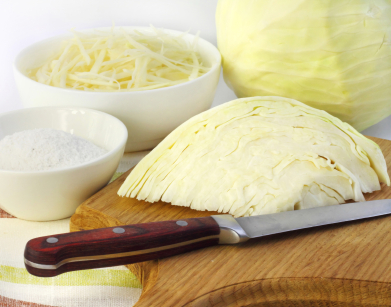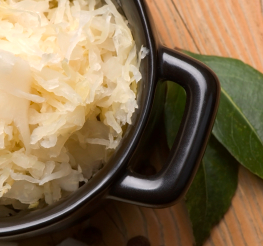Guest post by Raya Ioffe of Raya Wellness
Sauerkraut is sexy! I bet you haven’t seen those two words together in the same sentence before.
What comes up for you when you think about kraut? Is it that cabbage stuff you put on a hot dog at a baseball game? Is it a strong smelling garlicky dish that your grandmother or great grandmother may have served?
There is literally a whole world of cultured and fermented foods and beverages such as kombucha, kimchee, kefir, kvass, miso, and more! And they are all great choices. For today we are looking at traditional sauerkraut, but all the benefits of other fermented foods are the same.
So what is so sexy about fermented vegetables?
They’ll give you..
1) Glowing skin
2) A flatter tummy
3) Better digestion
4) More energy
5) A stronger immune system
Alright, Are you in?
What I’m talking about is old fashioned, lacto-fermented sauerkraut (pickled cabbage).
What in the world is lacto-fermented?
Lacto-fermented means the good bacteria that live on your veggies, in this case cabbage leaves, are kept alive and are cultured so that the “beneficial bacteria” – the lacto-baccilli – are working for you. Lacto-baccilli are the friendly bugs in your gut, making lactic acid, and making your tummy happy! They keep the bad bugs such as opportunistic bacteria, yeasts, and parasitic bacteria from taking over and making you sick.
The more of these probiotic (gut friendly bacteria) you have, the stronger your immune system – therefore less colds, less tissues, less missed days of work and more time to take “mental” health days.
How do the bacteria help?
These good bacteria are living organisms and just like you, they have to eat. When they eat the sugars from cabbage leaves or carrots for example, one of their by-products is lactic acid.
Lactic acid? Isn’t that bad?
Nope! This is the good kind of acid you want working for you in your stomach. Acid helps to lower the stomach pH and makes it a less hospitable environment for the bag buggies that can come in our food. Acid in your stomach activates digestive enzymes that help break down proteins. This means less gas and bloating. When you eat kraut, it actually alkalizes your blood. You want that! When you are alkaline, you get back to a strong immune system – less yeast infections, less inflammation, less breakouts. You get that “healthy glow.”
When is it good to eat kraut?
For maximum digestive power, consume kraut with your meals, especially foods that are high in protein. But, anytime you can get it in would be fantastic!
Where do I find lacto-fermented kraut?
Look for it in your health food store’s refrigerated section. Make sure it says either “lacto-fermented”, “raw”, or “unpasteurized.”
How can I be sure if a particular kraut is alive with the good bacteria?
If vinegar is listed as one of the ingredients or if it is unrefrigerated, though it may be very tasty and it will be preserved for a very long time, it ain’t the cabbage with the best bacteria bang for your buck.

Easy Saurkraut Recipe:
Ingredients:
4 1/2 lbs of thinly sliced cabbage
1/2 lb of shredded carrots
3 Tbs of Sea Salt or Himalayan Salt
2 cups of water
Optional: couple of cloves of garlic, minced
Method:
Combine all of the ingredients in a large mixing bowl. Begin to knead the cabbage as if you would dough. Massage the salt into the cabbage and keep squishing it down and mixing it. The cabbage will begin to release more of it’s own juices and you will end up with a lot of liquid and “less” cabbage.
Once you have massaged the cabbage, carrots, and salt for 5 or more minutes, you can begin to press it into a crock, a glass jar, or even a pot. Press it down as firmly as you can to get as much of the air out as possible (the lacto-bacilli like an anaerobic (no oxygen) environment). Press the veggies down with a plate and put something heavy on top like a jar filled with water so that as the kraut begins to ferment and gases are released by the bacteria they don’t push your veggies out of the brine. Finally cover this whole thing with a large kitchen towel.
Harvesting the kraut:
Tips and tricks:
• Weigh your cabbage at the store on one of their scales – close enough to 4.5 lbs plus or minus a bit will be fine.
• Cut the cabbage in half or quarters, and de-core it before slicing.
Here’s to peaceful digestion!

If you struggle with reflux, gas, bloating, IBS, constipation, diarrhea, colitis, Crone’s, and other digestive woes or want more “make your belly happy” recipes from Raya Ioffe, check out Raya Wellness!
Have you ever made feremented veggies before? Share your tips!



Samantha says
I assume that you leave this on the counter for the time it takes to ferment? You never actually state it in the recipe. And where do these lacto-bacilli come from typically. The air?
Raya says
Yes, you leave the kraut on the counter while it is fermenting. Once it’s done, you refrigerate it. Lactobacilli are naturally occurring bacteria on cabbage leaves. Happy fermenting!